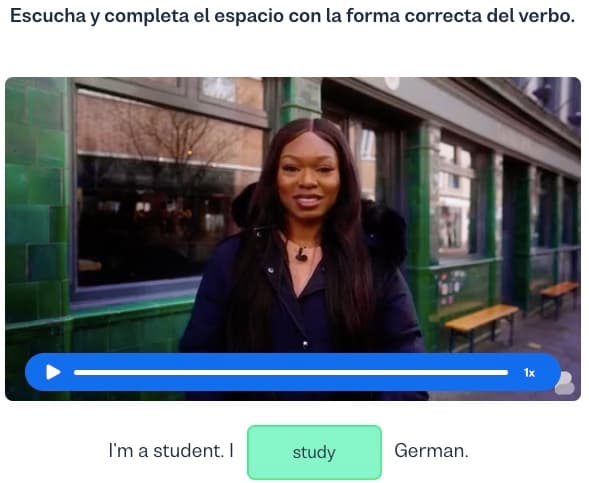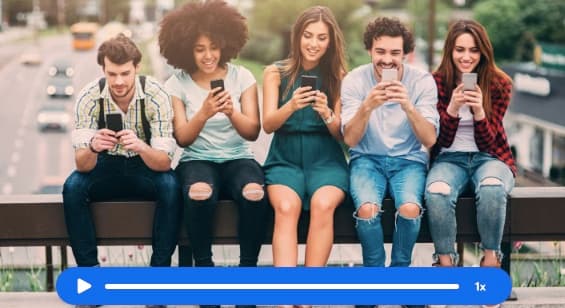I want to learn...
Ever wondered how some language learners can pick up new vocabulary quickly and easily? There are polyglots out there who’ve mastered more than five languages. What’s the difference between them and you? Well, after years of experimentation, they’ve found the methods that work for them.
The truth is, there’s no one way to learn vocabulary. Some people love spaced repetition. Some people get their vocabulary from reading. Others use flashcards.
Just like polyglots, you need to find the methods that work best for you. And we’re here to help.
In this guide, you’ll learn all about one of the most popular ways to learn a language: Flashcards. Then you can make an informed decision about whether it’s the right method for you.
The science behind flashcards
Flashcards are little bits of paper or card that have a word in your new language (or a picture) on the front, and the definition on the back. You use them by looking at the front and trying to remember the definition. Then you check the back to see if you’re right. They’re about as simple as learning resources get. But they’re a great way to learn vocabulary.
You can buy them pre-made or you can make your own. And nowadays you can get them through apps on your mobile device. Whichever way you access your flashcards, they’re meant to be portable. So you can use them whenever and wherever you want.
Let's dive into why flashcards work so well. Ever heard of the Picture Superiority Effect? It's a fancy term for a simple idea: Your brain remembers images better than words. And it’s proven to help second language learners remember new vocabulary.
Also, when you look at a flashcard and try to remember what’s on the other side (whether it’s an image or text), you’re doing active recall. Active recall is when you practice retrieving knowledge from your memory. And it’s a proven way to strengthen your learning.
Types of flashcards and their benefits
When you use flashcards, you have two options: The classic paper flashcards, or online / mobile app flashcards. They both share the benefit of being portable so you can practice whenever and wherever you want.
Paper flashcards (unless you buy pre-made, which we don’t recommend) take longer to set up. You need to source your own words and write them down with their definitions. But there are benefits to this. Research shows that taking it even further and adding a couple more steps to the creation process can boost your learning. This is called the Flashcards-Plus method. After you write the word and its definition, rewrite the definition in your own words. Then think of an example of the word from your own life. These two extra steps help your comprehension.
With digital flashcards a lot of the creation and organization of flashcards is automatic. This takes the guesswork out of your vocabulary learning. Advanced AI algorithms show you the words you need, at the best time to learn them. For example, Busuu’s Vocabulary Review tool tracks all the words you study during your courses, and uses a spaced-repetition algorithm for your review. And Busuu’s Vocabulary Trainer creates quizzes and identifies your weaknesses to help you strengthen your vocabulary knowledge.
Whether you use paper or digital flashcards, it’s important to choose one (or both) method that fits you.
Creating effective flashcards: A step-by-step guide
Whether you use paper or digital flashcards there’s one important question you need to answer: Should you buy pre-made ones or create your own? Research shows that creating your own flashcards is more effective. But don’t worry — this guide will show you how to make flashcards that will help you smash your vocabulary learning goals.
Step 1: Choose your format
Both digital and paper flashcards are portable and effective. So, how do you choose? Well, if you like the physical act of flipping through cards, paper’s for you. But if you want features like progress tracking or automatic spaced-repetition algorithms, choose digital.
Step 2: Select your content
When choosing words for your cards, focus on one concept per card. Don’t overcrowd your cards with details. For language learning, you can mix vocabulary, grammar rules, and common phrases. You can take language from your online language lessons, from the books you read, or the conversations you have.
Step 3: Design your cards
Remember, one of the big benefits of flashcards is their portability. If you choose to go the paper route, make sure your flashcards fit in your pocket.
For digital cards, make sure the words and images are easy to see on your screen. Luckily, many flashcard apps offer customization and templates you can use.
Step 4: Add visuals and context
When writing (or drawing) on your flashcards — if you use paper flashcards — do it in your cleanest handwriting. Add text, images, or icons that relate to the word or concept. Use colors to categorize different types of content (e.g., blue for verbs, pink for nouns). Paper flashcards give you more flexibility when it comes to adding content. But don’t forget, it takes longer to make them.
Step 5: Write concisely
Keep the text brief and to the point. For example, on a Spanish vocabulary card, write “Manzana” on the front and “Apple" on the back. Don’t put too much information on the card.
Step 6: Organize your deck
Keep your flashcards in a logical order. For example, you might group all food vocabulary together. It doesn’t matter how you organize the cards, as long as it makes sense to you. And for digital cards, take advantage of sorting and tagging features in apps.
Step 7: Test out your deck
After using your flashcards for a while, take a moment to think about their effectiveness. If something isn’t working — for example, the order of the cards, or the design — change them. Find what works best for you. And don’t be afraid to throw away cards that aren’t helping you.
Side note: A bigger pack naturally leads to more spacing between repetitions which is better for your memory recall. So don’t worry about adding too many cards (unless it gets too big to fit in your pocket).
How to effectively use flashcards to learn a new language
Okay, you’ve got your deck of cards ready to go. Now let’s look at how you can best use them. Here are some tips.
Be consistent. Flashcards should be part of your daily learning routine. Set aside a specific time each day for flashcard study. This could be during your morning coffee break, on your commute to work, or right before bed. Consistency is key.
Mix it up. Don’t just stick to vocabulary. Include phrases, grammar rules, idioms, etc. And rotate the topics — on Monday study vocabulary, on Tuesday study grammar, for example. This variety keeps your study sessions interesting.
Use the words you review. After reviewing a flashcard, use the word or phrase (or grammar) in a sentence. Slip it into your next conversation, or fit it into your next journal entry. This reinforces your understanding and gives you a chance to practice your new language naturally.
Space out your reviews. If you use paper flashcards, leave time between reviews. This can be really simple. Let’s say you review food vocabulary on September 1. Don’t look at food vocabulary again until September 15. The next time you review could be an even longer gap. Review food vocabulary on October 5, for example. As always, find the schedule that works for you.
If you're using digital tools — like Busuu’s Vocabulary Review — the app will take care of the schedule. It will give you words to review at the right time to help memorize them.
Teach other language learners. After reviewing a flashcard, teach the word, phrase, or grammar to someone else (join Busuu’s online community to find millions of language learners). This will give you a deeper understanding and strengthen your memory.
Flashcards are a simple, but powerful way to learn a language
Whether you go the old-school route of using paper flashcards or use modern AI-powered apps, follow the tips in this article to boost your language skills. Flashcards are great, but they aren’t a shortcut to mastering a language. Consistency and dedication are key to making them work. But keep at it, and flashcards are a proven way to master a new language.
Newlanguages


